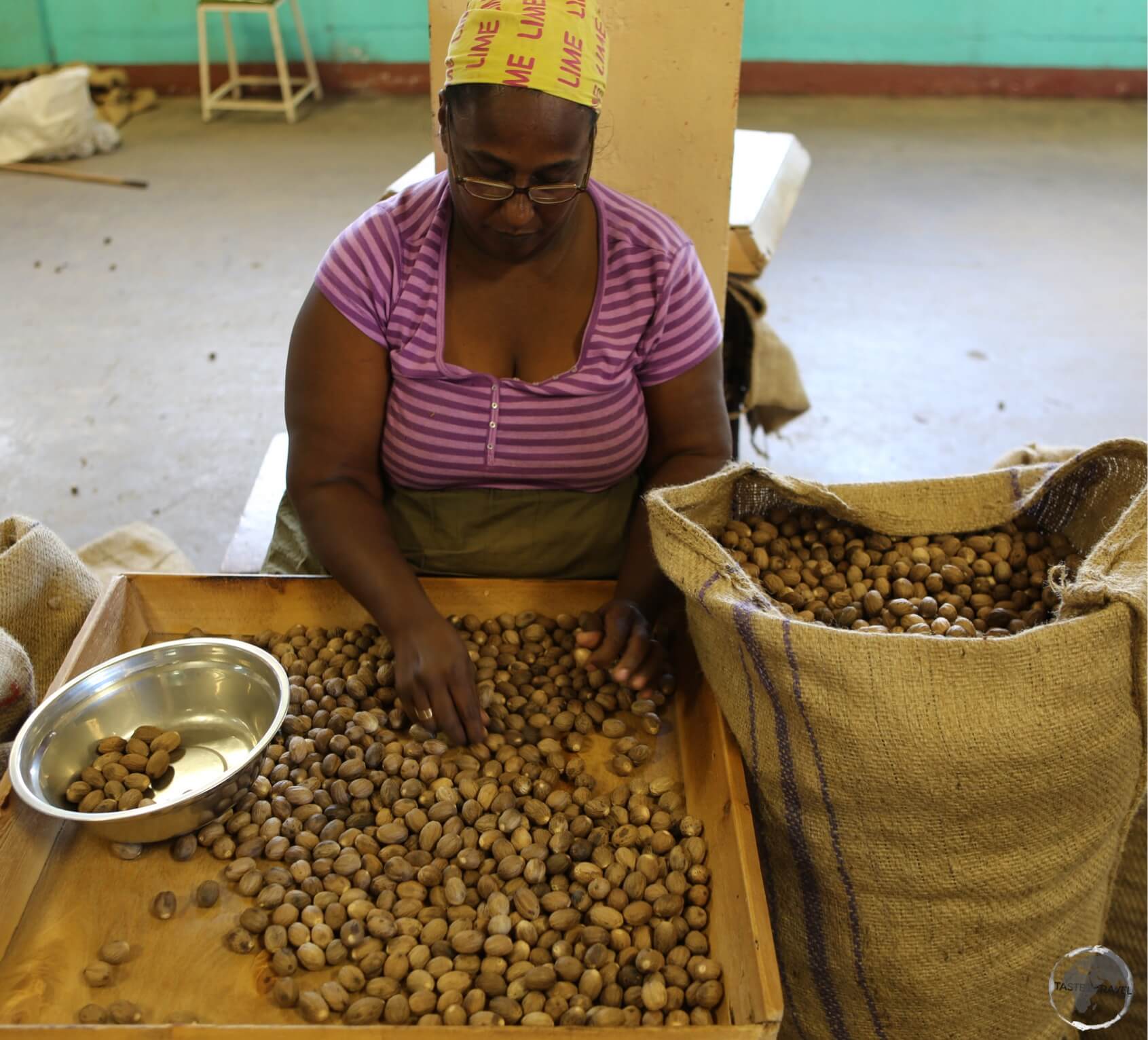Grenada Travel Guide
Welcome to the taste2travel Grenada Travel Guide!
Date Visited: April 2015
Introduction
Welcome to Grenada! Home to some of the friendliest people in the Caribbean. In this country you will normally be greeted by a warm welcome and a big smile.

Fishing boats at Crayfish Bay.
Grenada is the most southerly of the Windward Islands, located a short boat ride south of St. Vincent and the Grenadines. The country is known as the “Island of Spice” due to it being one of the largest exporters of nutmeg in the world, supplying 40% of the market.
Location
Located in the Lesser Antilles, Grenada consists of the main island of Grenada itself plus six smaller islands which lie to the north of the main island. It is located northwest of Trinidad and Tobago and south of St. Vincent and the Grenadines.
The country consists of the islands of Grenada (main island), Carriacou and Petit Martinique. The main island is 34-km long and 22-km wide. You could explore most of the island in a few days with your own car.
History
Grenada was originally inhabited by native Carib Indians until the French arrived in 1649. The French forced the natives to flee to neighbouring islands. The French remained on the island until the British took control in 1763. The French returned again for a brief period but then the British regained control and kept it until independence was granted in 1974.

Fisherman in St. Georges harbour
A coup in 1983, which resulted in the moderate government of Maurice Bishop being replaced by a strongly pro-communist government, concerned the US administration enough that President Ronald Reagan ordered US troops to invade the island. Once a new (friendlier) government had been installed US troops departed.

Nutmeg is Grenada’s #1 export.
Grenada has a population of about 110,000 – which, like other Anglo Caribbean countries, is comprised of people of African, East Indian and European descent.
Flag

The flag of Grenada.
The flag of Grenada consists of two yellow triangles at the top and bottom and two green triangles at the hoist and fly sides.
These are surrounded by a red border charged with six five-pointed yellow stars; three at the top centre and three at the bottom centre, along with an additional star on a red disc at the centre and a nutmeg at the hoist triangle.
Adopted in 1974 at the time of independence and designed by a local Grenadian, the representation of a nutmeg is symbolic of the islands’ primary export.
Currency

The Eastern Caribbean Dollar.
The official currency of Grenada is the Eastern Caribbean dollar. Headquartered in Basseterre, the Eastern Caribbean Central Bank (ECCB) is the monetary authority for the following Caribbean nations:
- Antigua & Barbuda
- Grenada
- St. Kitts & Nevis
- Dominica
- St. Lucia
- St. Vincent and the Grenadines
and the following British overseas territories:
The bank was founded in 1983 in order to maintain the stability of the Eastern Caribbean Dollar (EC$) and the integrity of the banking system of the member states.
The bank issues the Eastern Caribbean Dollar (EC$), which is the currency of the member states. Since 1976, the exchange rate has been pegged to the US$ at a rate of US$1 = EC$2.70.
Sightseeing
St. Georges

View of St. Georges, the capital of Grenada.
The capital and largest city (population: 4,500) of Grenada, St. Georges is located on the hillside of an old volcano crater, wrapped around a horseshoe-shaped harbour.
A stroll along the harbourside street – the Carenage – is a good way to familiarise yourself with the city. The Carenage is home to bars, cafes, restaurants, shops and is full of activity from fisherman selling their catch to boats being unloaded, repaired etc.

Boat moored alongside the Carenage in St. Georges.
The city is small and compact and most sites can be covered on foot in one day. In 2004 hurricane Ivan destroyed the city. Today many buildings, including many of the main churches are still to be repaired.

St Andrew’s Presbyterian Church was destroyed in 2004 by Hurricane Ivan
Around the Island
Gouyave

Learning about nutmeg from a guide at the Belmont Estate.
North of St. Georges is the west coast town of Gouyave. Worth a stop if you are passing through Gouyave is the Grenada Co-operative Nutmeg Association.

Nutmeg, laid out to dry, at the Grenada Co-operative Nutmeg Association.
At the co-op, you can learn all about the island’s #1 export while watching factory workers process the nut ready for export all over the world.

A worker at the Grenada Co-operative Nutmeg Association, sorting different grades of nutmeg.
River Antoine Rum Distillery

Rum from the River Antoine distillery.
This is a “must see” – a rum distillery founded in 1785 where the technology has not changed one bit.
The sugar cane is crushed by a huge waterwheel, the cane juice then flows into holding vats. The giant distilling pots are fired by workers who throw wood onto the fire. Everything here, including the bottling and labelling, is done by hand.

Firing the vats of alcohol at the River Antoine distillery.
The tour cost covers a sampling of the three different rums – it’s all rocket fuel stuff. Very potent!
Belmont Estate
If you are driving on the east side of the island you should aim to arrive at Belmont Estate around lunch time. The restaurant here does a great buffet lunch where you can try typical Grenadian cuisine. This is a popular lunch stop for the tour groups so it can get busy.
The estate is still in family hands. You can take a tour and learn all about the cocoa bean manufacturing and drying processes.

Cocoa beans drying at Belmont estate.
The onsite Grenada Chocolate Factory shop will satisfy the sweetest tooth.
Grenada Beaches

Sunset seen through a piece of fern coral at Morne Rouge beach.
The best beaches are in the south-west of the island, a short drive south of St. Georges.
The main beach with lots of white sand, beautiful Caribbean sea and great swimming is Grand Anse. Here you’ll also find hotels, dive shops and a small shopping mall (only one on the island).
Further south is the more secluded but equally stunning Morne Rouge. This is the best place to watch the sunset. There are some hotels on the beach here.

Sunset at Morne Rouge beach.
Scuba Diving

A camouflaged crab on a piece of brain coral.
The diving on Grenada is very good. An interesting dive site is the Underwater Sculture Park. You can also snorkel here as the sculptures are in about 10 metres of water. The park is a 5-minute boat ride from the dive shops on Grand Anse beach.
Carriacou Island

View from inside a ruined windmill foundation on Carriacou Island.
North of the main island, set like a stepping stone between Grenada and St. Vincent and the Grenadines, is tiny Carriacou Island.
Carriacou is home to 8,000 people. The capital city is Hillsborough, the only town on the island. Everything is a 5-min walk in this town. With a car you could tour the whole island in an couple of hours or walk it in a day.
Carriacou is reputed to be the friendliest, healthiest and safest island in the Caribbean. It is a pleasant place to spend some time.
Accommodation
You will find accommodation concentrated in the south-west corner of the main island either in St. Georges or along Grand Anse or Morne Rouge beaches. There are other options elsewhere around the island.
If you are going to Carriacou you should book in advance as accommodation is limited. Best to book using booking.com
Eating Out
Restaurants on the island offer all the regular international dishes plus lots of local seafood and lambi (conch). Calaloo soup (a leafy vegetable similar to spinach) is a local favourite as a starter.
As with the other Anglo Caribbean Islands, Chinese and Indian cuisine is also available.
You should not leave the spice island without trying nutmeg ice cream.
Visa Requirements
Some nationalities require visas for Grenada – check your visa requirements prior to arrival.
Getting There
By Air
International flights arrive at Maurice Bishop International Airport, which is located in the southwest of the island, 8-km south of St. Georges.
The following airlines provide international connections to Grenada:
- Air Canada Rouge to Toronto
- American Airlines to Miami
- British Airways to London (Gatwick)
- Caribbean Airlines to Port of Spain
- Condor (Seasonal) to Frankfurt
- Delta Air Lines (Seasonal) to Atlanta, New York (JFK)
- JetBlue Airways to New York (JFK)
- LIAT to Barbados, Port of Spain, Saint Vincent
- Virgin Atlantic to London (Gatwick)
By Sea
There are no scheduled international ferry services, however private operators connect Carriacou island (Grenada) to Union Island (St. Vincent and the Grenadines). The journey time is approximately 45-mins. Ask around in either port for the captains of these boats.
The only other way to arrive by sea is b
y private yacht or cruise ship.
Getting Around

My rental car on Grenada, where a 4WD is recommended to handle the rough roads on Grenada.
Public transport on the main island is very limited and non-existent on the smaller islands. You can view the bus routes here.
Taxis are also available.
The best option is to hire a car upon arrival at the airport. Before you hit the road you will need to purchase a Grenada drivers license from the police station at Grand Anse – your rental company will drive you to the station.
A daily passenger ferry runs between St. Georges and Carriacou with a connection to Petit Martinique. The ferry service is operated by Osprey Express Ltd. The ferry departs from the Carenage in St. Georges. The trip usually takes about 90 minutes, travelling up the west coast of the main island. For fares and schedule, refer to the Osprey Express website.
Safe Travels!
Darren
Follow me on Instagram:
[instagram-feed feed=1]
Further Reading
Other travel reports from the Caribbean region include:
Grenada Travel Guide Grenada Travel Guide Grenada Travel Guide Grenada Travel Guide Grenada Travel Guide








































